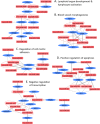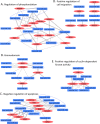Circulating small non-coding RNA signature in head and neck squamous cell carcinoma
- PMID: 26057471
- PMCID: PMC4662488
- DOI: 10.18632/oncotarget.4266
Circulating small non-coding RNA signature in head and neck squamous cell carcinoma
Abstract
The Head and Neck Squamous Cell Carcinoma (HNSCC) is the sixth most common human cancer, causing 350,000 individuals die worldwide each year. The overall prognosis in HNSCC patients has not significantly changed for the last decade. Complete understanding of the molecular mechanisms in HNSCC carcinogenesis could allow an earlier diagnosis and the use of more specific and effective therapies. In the present study we used deep sequencing to characterize small non-coding RNAs (sncRNAs) in serum from HNSCC patients and healthy donors. We identified, for the first time, a multi-marker signature of 3 major classes of circulating sncRNAs in HNSCC, revealing the presence of circulating novel and known miRNAs, and tRNA- and YRNA-derived small RNAs that were significantly deregulated in the sera of HNSCC patients compared to healthy controls. By implementing a triple-filtering approach we identified a subset of highly biologically relevant miRNA-mRNA interactions and we demonstrated that the same genes/pathways affected by somatic mutations in cancer are affected by changes in the abundance of miRNAs. Therefore, one important conclusion from our work is that during cancer development, there seems to be a convergence of oncogenic processes driven by somatic mutations and/or miRNA regulation affecting key cellular pathways.
Keywords: circulating small RNAs; head and neck cancer; microRNAs; next-generation sequencing; tRNA halves.
Conflict of interest statement
The authors declare that there is no conflict of interest
Figures





References
Publication types
MeSH terms
Substances
Grants and funding
LinkOut - more resources
Full Text Sources
Other Literature Sources
Medical

